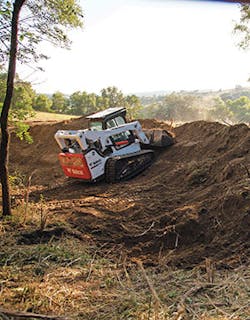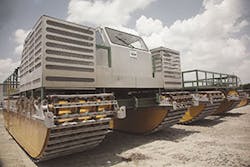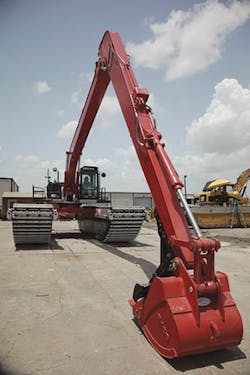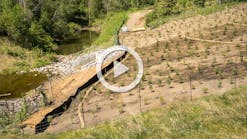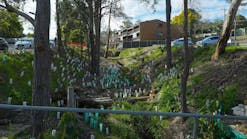Editor’s note: This article was first published in the January/February 2016 issue of Erosion Control.
Given the variety of jobs his company tackles each day, Myles Anderson, director of operations for The Erosion Co. in Woodstock, GA, depends on compact equipment to help execute the tasks.
Although the company is based in north Georgia, it also does jobs in Alabama, South Carolina, and Tennessee.
“We take care of erosion matters—anything to prevent soil from running off sites,” says Anderson. That includes silt fence installation, seeding, and stone works, among other approaches. The company has a fleet of 24 Bobcat track loaders: T180, T190, and T250.
“We put out a lot of Bobcats every day,” says Anderson. “Business is better now than it’s been in the last seven years. Georgia is doing very, very well right now.”
Anderson calls himself “old school” when it comes to equipment.
“For what we do, we don’t need a heavy machine,” he says. “We want it as light as possible and we want it as simple as possible.”
Anderson’s goal reflects that of many erosion control contractors who use compact equipment on the job site. Although there is no such equipment built specifically for erosion control work, contractors do use a variety of loaders, bulldozers, tractors, backhoes, and excavators to perform their jobs efficiently.
Turning radius on compact equipment is important when erosion control contractors need to get in tight spots such as between buildings or in areas where it’s important to not disturb any more dirt than one must, such as golf courses or developed areas where some of the landscaping is already in place. Tracked equipment minimizes compaction and damage. Attachments add versatility.
A Bobcat compact track loader
Anderson favors the versatility of Bobcat machines and says using them saves on hand labor.
“Each Bobcat also has a trencher that goes out with it for cutting into the soil and cutting down to the depth we need,” he says. “It’s a lot quicker and more efficient than hand digging.”
He also likes the small machines’ maneuverability.
“If the soil is damp, the track will ride over it easier than wheeled machines will,” he notes.
Attachments used by The Erosion Co. to get the job done include buckets, trenchers, grappling buckets, bush hogs, and street sweepers.
The company buys the equipment rather than leasing it. “We keep it for a much longer time than a lease,” says Anderson. “We’re big enough that we have our own mechanics and maintain all of our equipment.”
Because there is a learning curve to using compact equipment, each new hire must go through a training period with an experienced crew person, says Anderson. In-house training for foremen is usually a one-month process. The goal is to ensure each new employee is comfortable operating a machine.
“Safety is very important to us,” says Anderson. “They basically have a test here at the shop before they’re allowed to go out with the machine on their own.”
John Deere
John Deere offers a line of compact equipment appropriate to use for erosion control work, notes the company’s product marketing manager, Gregg Zupancic. In addition to skid-steers and compact track loaders (CTLs), John Deere makes compact, lightweight excavators onto which a contractor can place various-sized buckets for cleaning water rights of way and performing other tasks.
The company has five models of skid-steers, four models of CTLs, and five models of compact excavators; capacity and horsepower increase with size.
The skid-steer line starts with the 318E model at 1,950 pounds of rated operating capacity, and ranges up to the 332E, which offers 3,200 pounds of rated operating capacity.
The compact track loader line starts with the 319E model at a rated operating capacity of 2,150 pounds and ranges to the 333E model, with a rated operating capacity of 3,300 pounds.
John Deere has five compact excavator models, from the 17G to the 60G, says Zupancic. The digging depth for the 17G is 7 feet, 2 inches, and the 60G’s digging depth is 12 feet, 4 inches.
Job-site versatility is the reason skid-steers and track loaders are popular, he notes. That is due in large part to the wide variety of attachments for the front of the machine.
Contractors who work with a skid-steer or track loader to shape the land, dig a trench or a ditch, or clean out sediment often opt for a standard bucket attachment. A more specialized choice can be a dozer blade, akin to that found on a larger machine like a crawler or a bulldozer, says Zupancic.
“You can put a blade on the front that has up to eight different angles, so if you want to cut a side slope or make a valley to let the water run through, a dozer blade is a good choice,” he says.
The company also offers land planes. “It’s an attachment that goes on the front and basically planes or shaves off material or dirt off the land, like you plane wood with a tool,” says Zupancic.
A backhoe attachment also is useful on an erosion control job site. “That would make a skid-steer or compact track loader essentially into a compact excavator; it’s got a long arm and a bucket for digging out a ditch or clearing sediment out of a small pond,” he says.
If the job calls for removing debris, contractors can use a grapple on the front of the machine.
“It’s basically like a bucket bottom, but you have the ability to open and close a clamshell-type bucket on the top hydraulically,” says Zupancic. “Let’s say you wanted to place stones in and out of some runoff just to make the water flow the way you want it. You might have to clear logs and stones.”
John Deere also offers a multipurpose bucket that is similar to a bucket, but can open up. It features a dozer blade.
“The bucket separates hydraulically, so you can use it as a dozer blade to shape the land, but you can also close it any distance you want, and that would be more like a grapple,” says Zupancic, adding the attachment is helpful for jobs where the contractor wants to move rocks, but wants dirt and sand to fall through the bucket. It’s also a useful attachment for removing debris or shaping, he adds. The company also has a rock bucket, a rigid bucket with holes in it that enable large debris to fall out.
There are times in doing erosion control work that a contractor does not want high-ground-pressure so the equipment doesn’t sink, and other times when the contractor wants the ground tightly compacted, points out Zupancic. The latter might involve compacting the land for a bank or a slope that runs into a waterway. John Deere offers vibratory rollers, compaction devices that can be hooked up to the front of a skid-steer.
“They weigh a lot. You roll them across the ground and they vibrate and they pack the ground down nice and tight so you can make sure the river or the bank doesn’t get eroded away,” says Zupancic.
The company offers two styles of vibratory rollers. One is a sheepsfoot roller that encompasses small steel pads around the rolling drum and offers high pressure for jobs where the ground must be tightly compacted. For a smooth finish, there is also a smooth drum vibratory roller.
“The skid-steer is like a compact track loader,” notes Zupancic. “The key difference is the skid-steer has higher ground pressure, typically 30 to 35 pounds per square inch of ground pressure under the tire. A compact track loader is different in that there is a lot more rubber on the ground, spreading the weight of the machine across a wider area. The compact track loader has only 4 to 5 pounds of ground pressure per square inch, so it essentially floats better in soft ground conditions.”
For contractors working along a muddy bank, for example, a CTL will sink in less, so the equipment offers the ability to get more work done around waterways, says Zupancic.
“The CTL also provides much more stability. If the waterway is very steep and you want to reshape a slope, a CTL has a lot more track on the ground so you can work on steeper slopes than with a skid-steer, which has four wheels,” he says. “The contractor has to make a choice as to what would be best and most versatile, depending on the work that is most often done.”
For contractors on a limited budget, the CTL machines are more popular, says Zupancic. “They have a slightly higher acquisition cost,” he adds. “They have that undercarriage and rubber tracks—all of that rubber on the track system costs more than four rubber tires. But for contractors looking for less ground disturbance and more floatation, it would be a machine that’s better suited for those jobs.”
For those who do work that requires high ground pressure and who want to move quicker, skid-steers are more nimble with their faster travel speeds, says Zupancic.
“There are some applications where the contractor is trying to create a runoff way for water to flow to eliminate erosion in other areas at a job site,” he says. “A lot of times when the contractor is doing a waterway or stream bed, they’d want higher ground pressure to pack it down before the water starts flowing to limit the amount of erosion.”
For a contractor who can afford just one piece of equipment, there are different tradeoffs, says Zupancic. It essentially boils down to the tasks most commonly performed.
“The skid-steer is more nimble; it’s a little quicker,” says Zupancic. “It does have a tighter turning radius because it doesn’t have that undercarriage beneath it. Skid-steers and CTLs typically have the tightest turning radiuses of any construction or compact type equipment that’s available just by their size, but the skid-steer typically has a tighter turning radius versus a compact track loader.”
Maintenance on the equipment can be done in-house by companies equipped to do so. Zupancic says not much maintenance is involved, aside from changing the oil every 500 hours, which can equate to once a year.
“There is daily maintenance, where you make sure the tracks are tensioned properly, there is the right air pressure in the tires, and the machine is greased properly,” he adds.
Some contractors may find it more economical to subcontract the maintenance while devoting their time to performing the jobs. Major repairs are best handled by the dealer, he adds. Many John Deere dealers will visit the job site to do the maintenance as well.
As for the learning curve on the equipment, “skid-steers and CTLs are the easiest to operate of any piece of construction equipment,” says Zupancic. “They can be productive with no special skills and a small amount of practice time. These pieces are often referred to as the entry-level product for the construction and landscaping sectors of the industry because of their size, price point, versatility, and ease of operation.”
CASE Construction Equipment
CASE Construction Equipment recently introduced what is designed to be the industry’s first Tier 4 Final compact track loaders with selective catalytic reduction (SCR) technology, the radial-lift T340 and vertical lift TV380.
“The SCR solution is easy and relatively hands-off. Operators who remember to top off their diesel exhaust fluid tank while refueling will notice no other day-to-day changes,” says Warren Anderson, brand marketing manager with CASE Construction Equipment. “There is no diesel particulate filter [DPF] to maintain or replace, and SCR allows for a more efficient use of fuel as all diesel is consumed in productive effort instead of regeneration.”
SCR is an after-treatment system that lowers exhaust temperatures and does not use fuel to burn off particulate matter.
“It’s great for fuel savings compared to solutions with DPFs,” says Anderson. “SCR technology is more efficient and requires less maintenance than DPFs, as it does not require filter replacement or upkeep. It also removes complexity for operators and maintenance staff by eliminating regeneration associated with DPFs.”
The CASE SCR solution is provided by Fiat Powertrain Technologies and is used in on-road trucking, heavy earthmoving, and agricultural applications. The technology is now being outfitted to benefit smaller engine ranges, including compact track loaders.
Both models feature best-in-class breakout force, torque, hydraulic flow, and 360-degree visibility. The models include standard heavy-duty front and side lighting and control handle detents to give the operator greater control and responsiveness.
The combination of size, strength, and flotation is designed for earthmoving applications requiring low ground pressure and minimal ground disturbance. The new Tier 4 Final models feature torque, breakout force, and standard auxiliary hydraulic flow.
The new radial-lift TR340 weighs 10,000 pounds with a rated operating capacity (ROC) of 3,400 pounds and a bucket breakout force of 8,700 pounds. The vertical-lift TV380 weighs 10,550 pounds and provides 7,510 pounds of bucket breakout force and an ROC of 3,800 pounds. Both machines are rated at 90 gross horsepower, produce 282 foot-pounds of torque, and increase hydraulic flow rates (standard is 24.2 gallons per minute and high-flow is 37.6 gallons per minute). The 25.5-gallon fuel tank extends run times and ensures that the machine works the entire day without refueling, says Anderson.
Heavy-duty features offered as standard equipment include a 950 CCA battery for consistent starts in cold weather, a more robust rear door for added protection, front and side lighting for working all hours of the day, a block heater, and an easy-access remote jump-start, says Anderson.
The TR340 and TV380 offer an EZ-EH (electro-hydraulic) setup menu with nine adjustable speed and control sensitivity settings designed to be adjusted effortlessly as applications change and allow the operator to match controls to comfort and productivity preferences.
A single rocker switch alternates between the CASE “H” operating pattern and ISO pattern controls for operators who are comfortable with one style or the other. New operator handles with detents are designed to improve controllability and feathering by providing greater responsiveness to the machine’s actions and movements.
All CASE Alpha Series CTLs feature a dozer-style undercarriage designed for stability on steep slopes and optimal performance in muddy and sandy terrain. The rigid track frame has fewer moving parts than suspension track systems for better maintenance and durability. The new CTLs feature triple flange rollers, which help prevent de-tracking on inclines by using dozer-style rollers with a larger inner-diameter flange positioned between the track lugs.
The cab is 3 feet wide for operator comfort. It is enclosed, fully sealed, pressurized against noise and dust, and has a low entry threshold for easy access.
The cab-forward design provides 360-degree visibility with site lines down to the bucket edge, curb lines, and to the rear of the machine. Features that further improve visibility include heavy-duty front and side lights, a skylight, ultra-narrow wire side screens, and a large and curved rear window.
For maintenance, routine service points are all located at the rear of each machine. The battery is housed behind its own side-entry panel at the rear of the machine for easy access and service. Both machines feature CASE’s easy-tilt cab for convenient access to the drivetrain compartment. Hydraulic quick couplers allow operators to quickly change attachments from the cab, while connect-under-pressure manifolds require no tools to connect or disconnect hydraulic lines.
Lighter, low-ground-pressure equipment is ideal for work in soil retention and erosion control, points out Anderson. “We’ve seen examples of retaining walls or other structures built as a method of holding back soil, and then someone operates too near to the top of the wall with a heavier machine. That retaining wall then bows out, or the ground near it is otherwise disturbed, and it can affect the integrity of that structure,” he says.
“Similarly, when working in swampy areas or near bodies of water, that lower ground pressure provides greater flotation over the earth and doesn’t undermine the integrity of the soil below it as much when compared to other machines.”
That is one of the reasons that compact track loaders have seized significant market share from skid-steers and other heavier pieces of equipment in landscaping, landscape architecture, erosion control, and grading work, notes Anderson.
“The low-ground-pressure tracked machine retains many of the same operating characteristics of similar wheeled machines such as skid-steers or heavier machines such as smaller dozers, but creates less ground disturbance and requires less touch-up work when the job is complete,” he says.
There are even some areas where compact track loaders improve operating performance over the more common skid-steer, he says. “Because of the tracks and the greater stability and surface area touching the ground, compact track loaders with the same frame size and footprint of a skid-steer will actually have greater lift capacities,” he says. “The greater stability and track surface contact with the ground also makes compact track loaders ideal for use with certain attachments such as trenchers and dozer blades. Compact track loaders are less susceptible to the “porpoising” you get with skid-steers as they travel over uneven land, and that greater stability and even travel plane is ideal for work with those attachments.”
In doing erosion control and landscaping applications where one is often working on softer ground with and over topsoil, CTLs also lessen the impact to the surrounding land and structures, reducing rutting and the need to touch up sites after work, says Anderson.
However, there are times when a comparable wheeled machine such as a skid-steer makes sense, he points out. “Rubber tracked machines experience greater wear when operating on improved surfaces such as concrete and asphalt. Compact track loaders working in such an environment will experience expedited track wear and replacement intervals, making a rubber-tired machine more practical.”
Helac Corp.
The Helac PowerTilt Hydraulic Bucket Tilting Attachment is designed to provide backhoes and excavators with up to 90-degree left and right bucket swing for a full 180-degree total side-to-side swing capability.
“It does well when you’re finish grading, doing slopes on a hill or even in ditches,” notes Jessica Howisey, Helac’s marketing communications manager. “It eliminates extra machines. You can use one and move that bucket all different angles versus moving the excavator around.”
The attachment pin mounts to the dipper stick. PowerTilt is furnished with two different, built-in couplers: the standard, hook-style mechanical quick-coupler uses original equipment manufacturer (OEM) pin-on buckets, and the optional universal coupler uses quick-hitch style buckets. The configurations are custom-designed for each machine brand, says Howisey.
PowerTilt can be combined with most hydraulic quick-couplers. Each PowerTilt is equipped with an internal cross-port relief valve that provides hydraulic overload protection. Seven PowerTilt models are available—sized by machine weight—for backhoes and excavators up to 75,000 pounds.
Helac Corp.’s hydraulic pin grab coupler option provides more choices in addition to the existing half hitch, Universal (Wain-Roy/CP), and brand-specific couplers. The pin grab coupler still allows the PowerTilt to rotate up to 180 degrees side to side. The variable pin center design allows easy pick up and change of the widest range of OEM attachments, says Howisey.
The PowerTilt hydraulic pin grab coupler option is designed to make it easier for the operator to change attachments from the cab. The coupler provides both a front and rear safety locking mechanism to secure both attachment pins and is designed to work in all types of severe and dirty environments.
Curling the attachment guarantees it is in a safe position for engagement and release, says Howisey. In the event of improper attachment connection, the front locking clasp retains the attachment to prevent unexpected separation. In case of hydraulic cylinder or hose failure, the rear sliding hook maintains connection to the attachment rear pin to prevent unexpected separation.
By allowing a change of attachments from the cab, the hydraulic coupler is designed to save an operator considerable machine operating time, offering the ability to reverse buckets to shovel mode at any time to excavate against walls, under pipes, and in other terrains.
The hydraulic pin grab coupler option is available for 5- to 30-ton excavators and loader backhoes in 18 coupler combinations.
With its ability to turn a 90-degree angle and get under pipes and utilities, the PowerTilt reduces manual labor on jobs, points out Howisey.
Amphibious Cargo Buggy
Marsh Buggies
There are some jobs for which conventional equipment cannot be used, such as on watery sites or marshes. Marsh Buggies designs, manufacturers, rents, and sells amphibious construction equipment for those situations. The company also serves as a contractor for erosion control jobs.
One predominant use of the equipment is terrace and levy construction. The company constructs terraces and, once a barrier is formed, material dredged from another location can be pumped into the area to re-create a marsh that had previously eroded.
Amphibious excavator
For operators learning to use a Marsh Buggy, many functions are identical to those of a highway machine or a land excavator such as boom, stick, bucket, swing, track forward, track backward, notes Jamie Autin, who performs computer drafting and design and equipment sales for the company.
“The learning curve comes into play specifically when you get in waters of four to four and a half feet and above, and the equipment becomes completely floating,” she says. “Typically, a person who is well-versed in operating a land excavator can be transferred over to an amphibious excavator with minimal training.”
The Marsh Buggy is one of the most versatile compact machines for a construction site given its ability to work on both dry land and in shallow water, points out Autin.
“It does completely float, which allows it to transverse lakes, rivers, and canals to get from point A to point B,” says Autin. “It’s able to access areas that no other piece of equipment can access.”
Autin says one of the features of the Marsh Buggy that appeals to contractors is its very low ground pressure. The equipment causes minimal damage to any terrain on which it is used.
Leasing or buying the Marsh Buggy depends on what is more cost-effective for a particular company. “Some contractors own a lot of conventional construction equipment that serves 99% of the situations they work in, but then a project pops up and they need this type of specialized equipment probably just this one time for a couple of months, so leasing is the better option for them,” she says. On the other hand, for long-term or frequent projects in and around water, it makes sense for the contractor to buy the equipment, which can pay for itself several times over, adds Autin.
Typical maintenance for the equipment includes preventative maintenance such as oil and filter changes and fluid checks.
Marsh Buggies trains end users in maintaining the tracked system by keeping it lubricated, tightening the tracks, and detecting when the tracks are worn down and when components need to be replaced.
The company rents its equipment with or without an operator.
“Typically, the maintenance for the duration of that lease is the client’s responsibility,” says Autin. “When we rent our equipment with an operator, we then rent that equipment fully operated and maintained by our employees.”
Marsh Buggies often serves as the contractor of record for terrace construction projects in the coastal marsh areas of southern Louisiana. Terraces serve as small levies.
Marsh terracing involves constructing linear mounds of earth from excavated subtidal substrates, which subsequently become colonized by emergent vegetation.
“Terraces are most often constructed in large water bodies that were once emergent marsh but have converted to open water as a result of exposure to a variety of marsh loss factors,” says Autin.
Terraces are usually designed with a crown height equal to surrounding marsh elevation to enable periodic tidal inundation of the terraces and associated vegetation. They are usually planted with native grasses to promote stabilization and decrease erosion, she says.
Marsh terraces were conceived as a potentially effective restoration technique, partly because of their ability to interrupt the negative feedback cycle of marsh erosion that is initiated once interior marshes begin to fragment, says Autin.
“In this cycle, as intact marshes begin to fragment and convert to open water, fetch increases and enables production of greater wave energy, which in turn increases marsh erosion rates, ultimately accelerating conversion to an ever-expanding body of open water,” she says.
Marsh terraces function similarly to other restoration techniques such as breakwater and sediment retention structures to break this cycle by reducing fetch and subsequent wave energy, thereby increasing the potential for sediment deposition in the leeward side of the structure.
Terraces may be implemented to achieve one or multiple coastal restoration objectives, such as creating emergent marsh through establishment of vegetation on the terraces themselves, increasing marsh edge, reducing turbidity to increase light penetration into the water column and promote growth of submerged aquatic vegetation, reducing erosion of adjacent marsh by reducing fetch and wave energy, and promoting the growth of emergent marsh through gradual accumulation of sediment and subsequent colonization by emergent vegetation within the terrace field, outside the terrace footprint.
“When these objectives are achieved, terraces may benefit both fisheries and waterbird species dependent upon emergent marsh habitats,” says Autin.
Use of marsh terraces as a coastal restoration technique has been most prevalent in Louisiana, but is becoming more common in Texas, she adds. “Since 1990, marsh terraces have been constructed at more than 80 sites in Louisiana and Texas, encompassing more than 4,320 individual terrace ridges.”
Autin says her company uses up to four machines in the area to construct terraces with specified height, width, and slopes. Once the terraces are constructed, the company returns to plant marsh grass.
Some projects are done in conjunction with Ducks Unlimited, an international nonprofit organization dedicated to the conservation of wetlands and associated upland habitats. One such project is the Bayou L’Ours terracing project, of which there are several phases. In the third phase, Marsh Buggies expects to construct and plant 25,800 linear feet of marsh terraces. Half of the terraces have been completed to date; the rest are expected to be done starting in January 2016.
“Once completed, this phase of the project will enhance approximately 250 acres of marsh habitat,” says Autin. The project is in response to the crisis of coastal wetlands loss along the Gulf Coast.
Takeuchi
Takeuchi’s line of compact construction equipment can be used in a wide range of applications including erosion control and management, notes David Caldwell, product manager. It includes three compact track loaders, six skid-steer models, and three compact wheel loaders. The company has seven models of excavators, all with long arm configurations designed to offer greater working ranges and less repositioning of machines. The rubber track is designed to cause minimal disturbance.
Key features of the TB216 excavator include a compact design with retractable undercarriage of 38.6–51.2 inches, allowing access to areas unreachable by larger equipment, and a backfill blade with removable end bits.
The TB230 is less than 5 feet wide to provide greater accessibility between gates, homes, and other buildings. Other features include a backfill blade with float position, an optional angle blade, and a multifunctional monitor panel with multiple attachment presets.
The T240 and TB260 are designed with increased power for greater productivity and feature attachment platforms, dual auxiliary hydraulics (TB260), a backfill blade with float position, optional cab air-conditioning, optional angle blade, and a multifunction monitor panel with multiple attachment presets to enable the operator to change hydraulically powered attachments quickly. The TB290 has similar features. All feature a thumb mount.
The TB280FR is designed as a tight tail swing machine with a side-to-side boom for greater visibility of the work site and attachments. The machine also allows the boom to be offset to the right side and stowed next to the cab so it can work full rotation within a very tight radius. It includes an attachment platform, dual auxiliary hydraulics, a backfill blade with float position, standard cab air-conditioning, and a multi-function monitor panel with multiple attachment presets to enable the operator to change hydraulically powered attachments quickly and efficiently.
The TB1140 Series 2 is considered a “big” compact excavator because of its boom pivot and backfill blade, says Caldwell. The pivot boom allows the machine to dig in an offset right or left position, enabling it to work in confined areas such as bridge and roadside work. “It’s also very quiet when traveling,” says Caldwell.
There is an available wide steel track for even greater flotation to avoid disturbing sensitive areas, he adds. The machine has an attachment platform, a backfill blade with float position, and cab air conditioning.
Excavator attachments for erosion control work include excavating buckets, ditching and grading buckets, tilting couplers, hydraulic thumbs, grapples, grading blades, and rotary and flail mowers.
A key feature of Takeuchi’s compact track loader TL8 is a 15-inch track designed for greater flotation, says Caldwell. “Its compact design makes it easy to transport and allows the loader to access areas that a larger loader simply cannot,” he adds.
The machine provides a 33-gallons per minute (gpm) flow designed for greater attachment versatility.
The TL10 features a 17.7-inch block-style track for greater flotation, while the TL12 features a “more aggressive” 17.7-inch bar-style track for greater traction, says Caldwell. The flow on the TL10 is 36 gpm; the 40 gpm of the TL12 is ideal for mulching heads and rotary cutters that require increased flow, says Caldwell.
Track and skid-steer loader attachments for erosion control include a box blade, smooth lip and tooth buckets, brush grapple, dozer blade, flail mower, forestry mulcher, Harley rake, land plane, rock bucket, root rake, rotary cutter, silt fence installer, spreader, rotary tiller, and over-the-tire tracks for skid-steers to provide greater flotation in soft, uneven terrain.
Whether a contractor chooses to perform maintenance on a machine in-house depends on whether he or she has the right tools and equipment to service and maintain the machine properly and safely, says Caldwell. Another consideration is the contractor’s ability to perform repairs ranging from basic maintenance to more complex issues that may arise. Caldwell recommends that OEM parts always be used when doing maintenance and repairs.
In choosing to outsource the maintenance, Caldwell points out that some companies may have “attractive” maintenance contracts.
“Many of today’s machines are equipped with telematics that make it easier for customers and dealers to schedule and plan for downtime,” he says. “Dealers also can pull parts ahead of time for routine maintenance for greater convenience and efficiency.”
Purchase, Lease, or Rent?
One major decision contractors must make with compact equipment is whether to purchase, lease, or rent it. The types of jobs that the equipment will be used to perform weigh heavily into that decision.
“Half the skid-steers and track loaders in the industry are purchased flat out with cash,” notes Gregg Zupancic of John Deere. “Another 45% is done through financing. For the contractor who doesn’t have a lot of jobs needing the equipment, or if the jobs are sporadic, leasing is a good way to go because the contractor can trade out the machine for a different model after the lease period, which is typically about three years, or walk away from the lease without having to worry about resale.”
David Caldwell of Takeuchi points out that leasing is a better option for contractors who want to conserve capital and free up funds for other company expenditures. “It’s a good alternative for folks who have seasonal work,” he says. “Setting payments for a certain length of time simplifies budgeting. Contractors can often find lease options that have flex-pay alternatives.”
Reasons against leasing include potentially higher rates than purchasing equipment, Caldwell points out, adding that manufacturers “often have very attractive finance rates for equipment purchases.”
Renting is another alternative to buying or leasing.
“You use and pay for equipment only when you need it,” he says. “Equipment can be returned, which is great if a job falls through or business drops off. Equipment rental periods can be determined by amount of work a contractor may have, and the term can range from daily to weekly to monthly to annually.”
Renting may preclude a purchase, says Caldwell, adding that the contractor can determine if a piece of equipment is right for the job. “It provides an opportunity evaluate a particular product or model before making a purchase.”
Rental fleets typically feature newer and updated equipment, giving contractors the opportunity to try the latest features and technology, notes Caldwell. Budgeting is easier with a set cost per month, he adds.
If equipment can be kept busy throughout the year, purchasing it the best option, Caldwell says. That assumes the contractor has a down payment and favorable credit score. Purchasing allows the contractor deductions through machine depreciation, repair, and taxes and interest paid. “That’s beneficial to an individual or company trying to reduce their exposure come tax time,” he says.
Other factors to consider: Is it more financially feasible for a contractor to do maintenance in-house? What are requirements for hauling equipment from job to job? Does the contractor have the appropriate truck, trailer, and license to transport the machine?

